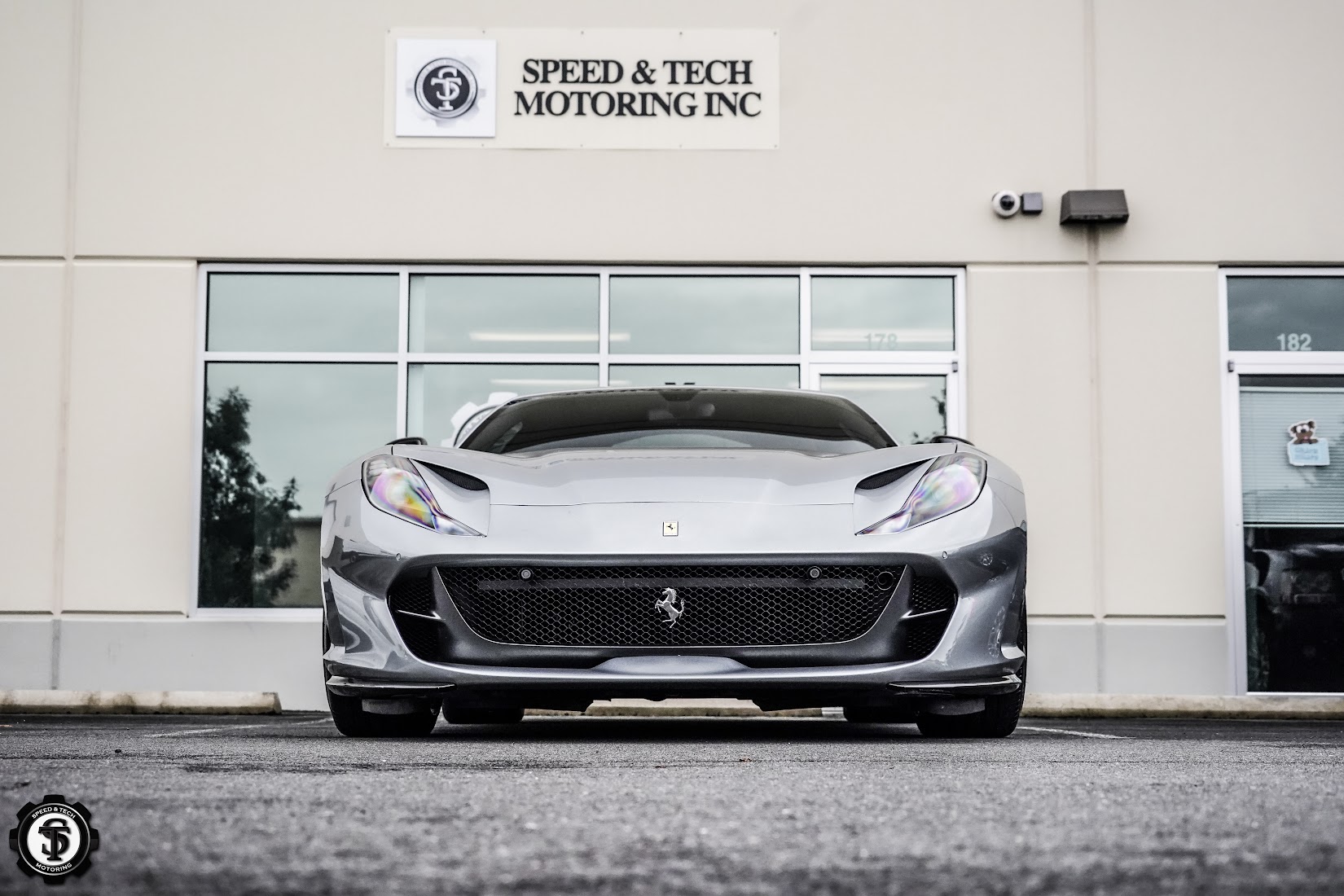Introduction: Why You Can’t Skip Paint Correction Before Ceramic Coating
Ever wondered why some ceramic coatings last for years while others lose their shine in months? The secret isn’t just the brand of coating—it’s all about the preparation. Paint correction is that crucial step before applying ceramic coating that often gets overlooked.
Imagine sealing a hardwood floor without sanding it first. You’d just lock in scratches and bumps. It’s the same with your car’s paint. If you skip paint correction, all those swirl marks, light scratches, and water spots stay permanently visible under that high-gloss layer.
Paint correction creates the ideal surface, allowing ceramic coatings to bond more effectively and deliver that mirror-like finish. Let’s dig into why this step is non-negotiable if you want long-term protection and next-level shine.
What Is Paint Correction?
Breaking It Down in Simple Terms
Paint correction is a specialized detailing process that removes imperfections from your vehicle’s clear coat. It’s not just buffing. It’s a multi-step process involving machine polishing, abrasive compounds, and expert skill.
Common paint issues that paint correction targets:
- Micro scratches from improper washing
- Swirl marks caused by automatic car washes
- Water spots etched into the surface
- Oxidation that dulls paint
- Bird dropping stains and bug residue
Think of it as giving your car’s paint a fresh start. Before adding a protective ceramic layer, the surface is leveled and refined until it looks flawless. Professionals like Speed & Tech Motoring use this step to ensure every inch of your car looks showroom-ready before sealing it with a ceramic coating.
What Is Ceramic Coating?
Ceramic coating is a liquid polymer applied to a vehicle’s exterior that cures into a solid, hydrophobic, and UV-resistant layer. It protects against:
- Water spots
- Chemical stains
- Bird droppings
- Oxidation and UV fading
Ceramic coating enhances gloss, reduces cleaning time, and repels dirt. But without proper surface prep—meaning paint correction—you’d just be sealing in flaws like swirls and scratches under a hard, clear coat.
Speed & Tech Motoring emphasizes that ceramic coatings amplify whatever surface they’re applied to. That’s why paint correction always comes first in a professional detailing setup.
Why Paint Correction Before Ceramic Coating Matters
1. Locking in Flaws Is Not What You Want
If you apply ceramic coating directly over uncorrected paint, it locks everything underneath it—scratches, swirl marks, water etching, and all. Once that coating cures, those flaws are trapped for years.
It’s like laying down tile without smoothing the floor underneath. The imperfections will show through the finished surface.
2. Maximizing Gloss and Shine
One reason people get ceramic coatings is to achieve that deep, wet-look gloss. But ceramic coating doesn’t create that gloss—it only enhances what’s already there.
Paint correction levels and polishes the clear coat, setting up that perfect canvas for the coating to magnify.
3. Longer-Lasting Protection
Ceramic coatings bond best to smooth, defect-free surfaces. Paint correction ensures uniform bonding, which means better hydrophobic properties, improved chemical resistance, and longer-lasting results.
The Science Behind Paint Correction
Paint correction isn’t a “quick buff.” It’s a meticulous, multi-step process involving professional tools and precise techniques.
Here’s what it includes:
- Measuring Paint Thickness: Using a gauge to avoid removing too much clear coat.
- Machine Polishing: Starting with abrasive compounds, then moving to finer polishes.
- Surface Refinement: Multiple passes with different pads and products.
- Light Inspection: Checking the paint under LED and halogen lights to reveal hidden defects.
Shops like Speed & Tech Motoring use these steps to restore clarity, depth, and smoothness to your car’s paint before sealing it with ceramic protection.
Common Paint Imperfections Addressed
Even brand-new cars arrive with minor paint issues. Paint correction is designed to remove or minimize the following:
- Swirl Marks: Fine circular scratches caused by improper washing.
- Micro Scratches: Often invisible until sunlight hits just right.
- Water Spot Etching: Hard water minerals leave permanent marks if untreated.
- Oxidation: Fading and dullness from sun exposure.
- Chemical Stains: From bird droppings, bugs, tree sap, or harsh cleaning products.
These imperfections dull your paint, reduce gloss, and interfere with ceramic coating adhesion.
How Many Stages of Paint Correction Are There?
Not all cars need the same level of correction. Depending on the paint’s condition, a professional may recommend:
- Single-Stage Correction: Removes minor defects and restores light gloss.
- Two-Stage Correction: Combines cutting and polishing to tackle moderate flaws.
- Three-Stage Correction: Full paint rejuvenation—ideal for heavily swirled or older vehicles.
Speed & Tech Motoring evaluates each car individually before choosing the right correction level.
What Tools and Products Are Used in Paint Correction?
Professional paint correction requires specialized equipment:
- Dual Action Polishers for balanced, swirl-free correction
- Rotary Polishers for deeper defect removal
- Cutting Compounds and Polishes tailored to paint hardness
- Microfiber and Foam Pads in various grades
- Paint Thickness Gauges to monitor safe correction depth
Amateurs with store-bought polishers can do more harm than good. That’s why detailers like Speed & Tech Motoring invest in the right tools and training.
How Long Does Paint Correction Take?
Paint correction isn’t a 30-minute job. It’s time-intensive, and quality shops take their time to do it right.
Typical timelines:
- Single-Stage: 4–6 hours
- Two-Stage: 6–12 hours
- Three-Stage: 1–2 full days
The exact time depends on vehicle size, paint type, and condition. Detailers like Speed & Tech Motoring always provide realistic timelines rather than rush jobs.
Does Every Car Need Paint Correction Before Ceramic Coating?
Not every vehicle requires heavy correction, but even new cars benefit from at least a single-stage polish. Why?
New cars often have:
- Transport scratches
- Dealer-installed swirls from automated washes
- Light environmental contamination like rail dust
Paint correction ensures the best possible surface before sealing it under ceramic. Even if flaws seem minor, they can stand out under the coating.
What Happens If You Skip Paint Correction?
Skipping this step creates several problems:
- Visible Swirls and Scratches: Ceramic coating enhances, not hides, paint defects.
- Poor Coating Bonding: Uneven surfaces mean reduced longevity and protection.
- Diminished Gloss: The coating will look cloudy or uneven instead of clear and sharp.
Many vehicle owners who skip paint correction regret it—coming back later to have it done properly. Speed & Tech Motoring regularly fixes those mistakes.
How Speed & Tech Motoring Handles Paint Correction + Ceramic Coating
Here’s our step-by-step process for delivering flawless results:
Step 1: Inspection and Assessment
We measure paint depth, check defects under multiple lights, and discuss customer goals.
Step 2: Multi-Stage Paint Correction
Depending on what we find, we polish the vehicle using the appropriate compound and technique.
Step 3: Ceramic Coating Application
After correction, we apply the ceramic layer evenly, allowing it to cure properly.
Step 4: Quality Control Check
We inspect everything panel by panel to ensure the job meets professional standards.
Cost of Paint Correction Before Ceramic Coating
Prices vary depending on the vehicle’s size, condition, and correction level:
- Single-Stage Correction: $300–$600
- Two-Stage Correction: $600–$1,200
- Full Paint Correction + Ceramic Coating Package: $1,200–$2,500+
While it may seem like an investment, skipping it can cost more in the long run through premature coating failure.
How to Maintain Ceramic Coating After Paint Correction
Once your car is corrected and coated, here’s how to keep it looking pristine:
- Use pH-neutral wash soap—avoid strong detergents.
- Dry with microfiber towels to prevent new scratches.
- Avoid automated car washes.
- Apply ceramic boosters every few months.
- Schedule periodic inspections with your detailer.
Shops like Speed & Tech Motoring offer maintenance plans to make upkeep simple and stress-free.
The Long-Term Value of Doing It Right the First Time
Cutting corners on paint preparation might save a few bucks upfront, but it often leads to rework or disappointing results.
Doing paint correction first ensures your ceramic coating looks better, lasts longer, and performs as promised. That’s why serious detailers, including Speed & Tech Motoring, treat correction as a necessary part of the ceramic coating process.
Final Thoughts: Is Paint Correction Before Ceramic Coating Worth It?
Absolutely. Think of paint correction as laying a solid foundation before building a house. Without it, even the best ceramic coating won’t deliver its full benefits.
At Speed & Tech Motoring, we understand that removing imperfections, leveling the clear coat, and achieving a glass-smooth finish is key to unlocking both cosmetic brilliance and long-term protection.
For any car enthusiast or luxury vehicle owner serious about preserving their investment, skipping this step simply isn’t worth the risk.
5 Unique FAQs About Paint Correction Before Ceramic Coating
Can paint correction be done without ceramic coating afterward?
Yes, paint correction improves gloss and clarity on its own, but applying ceramic coating afterward helps lock in the results and extend protection.
How long does ceramic coating last with proper paint correction?
With proper prep and maintenance, ceramic coatings can last 2–5 years or longer depending on the product and environmental conditions.
Is paint correction safe for all vehicle colors?
Yes. Whether it’s black, white, red, or metallic paint, correction can be tailored to any color or type of finish, including clear-coated and multi-stage paints.
Can paint correction remove deep scratches?
Paint correction removes light to moderate scratches. Deeper scratches that reach the base coat may require repainting.
How soon can I drive my car after ceramic coating is applied?
It’s usually safe to drive within 12–24 hours, but full curing takes 5–7 days. Avoid washing or exposing the vehicle to heavy rain during that time.







